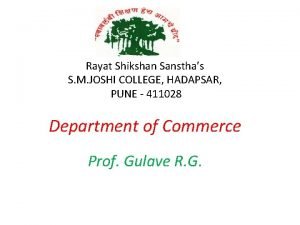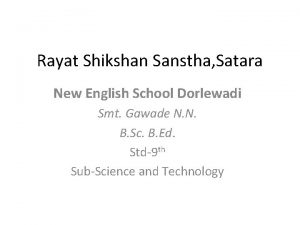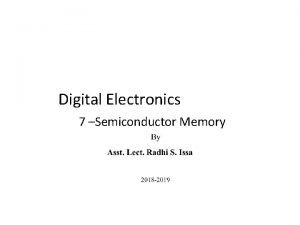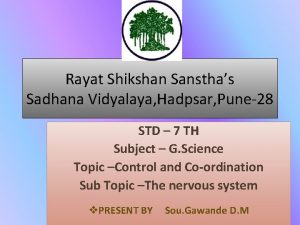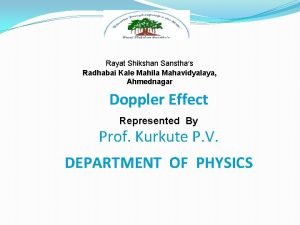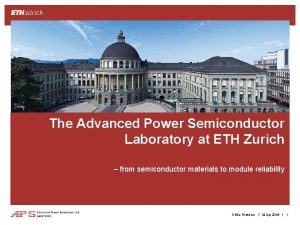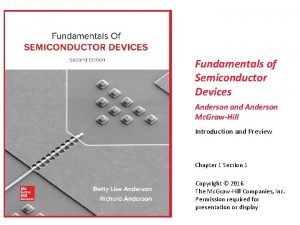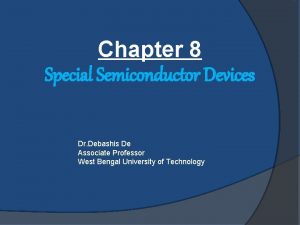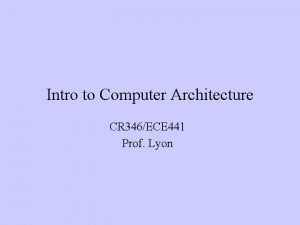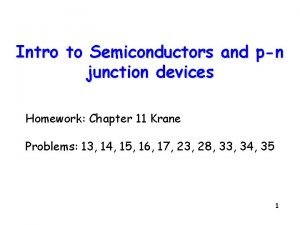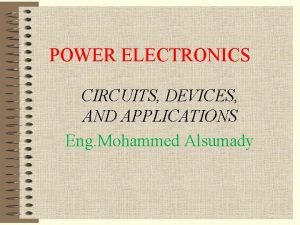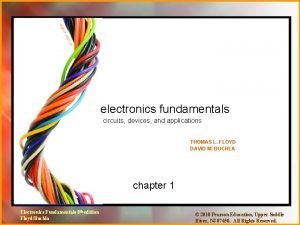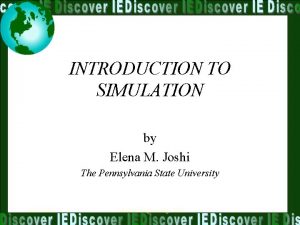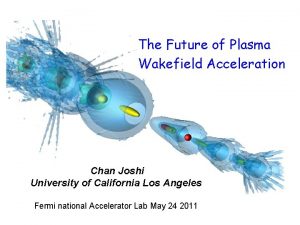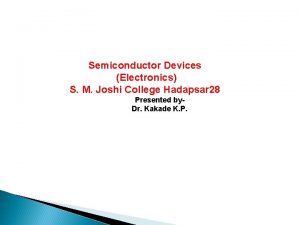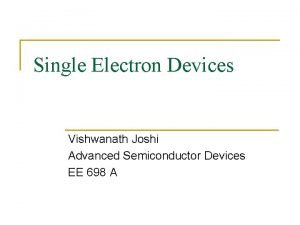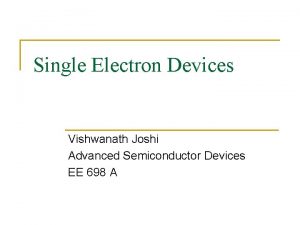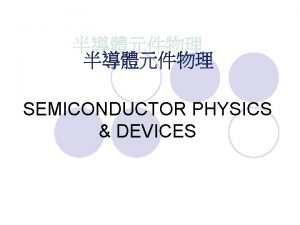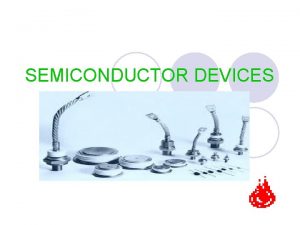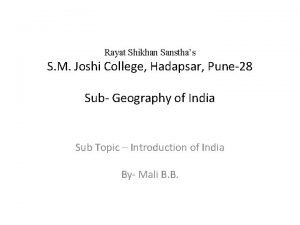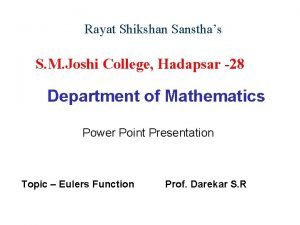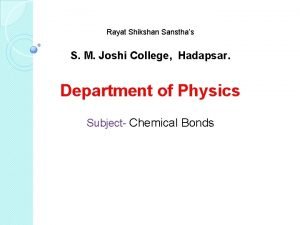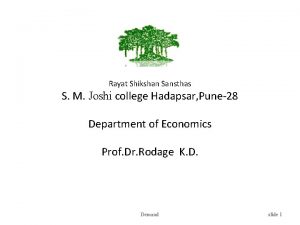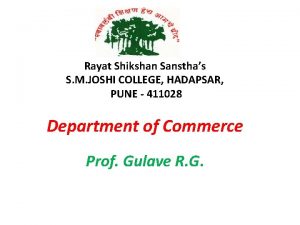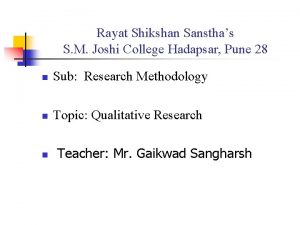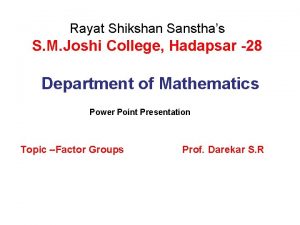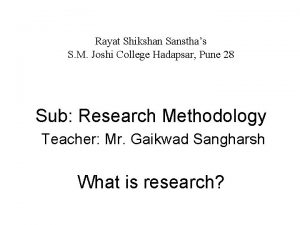Semiconductor Devices Electronics S M Joshi College Hadapsar
























- Slides: 24

Semiconductor Devices (Electronics) S. M. Joshi College Hadapsar 28 Presented by. Dr. Kakade K. P.

TRANSISTOR - Introduction BIPOLAR JUNCTION TRANSISTOR (BJT)

� � Introduction Beside diodes, the most popular semiconductor devices is transistors. Eg: Bipolar Junction Transistor (BJT) Transistors are more complex and can be used in many ways Most important feature: can amplify signals and as switch Amplification can make weak signal strong (make sounds louder and signal levels greater), in general, provide function called Gain

Transistor Structure � � � BJT is bipolar because both holes (+) and electrons (-) will take part in the current flow through the device ◦ N-type regions contains free electrons (negative carriers) ◦ P-type regions contains free holes (positive carriers) 2 types of BJT ◦ NPN transistor ◦ PNP transistor The transistor regions are: ◦ Emitter (E) – send the carriers into the base region and then on to the collector ◦ Base (B) – acts as control region. It can allow none, some or many carriers to flow ◦ Collector (C) – collects the carriers

PNP and NPN transistor structure P N N P P N Ic(m. A) IB(µA) IC(m. A) IB(µA) IE(m. A) Arrow shows the current flows IE(m. A)

NPN Transistor Structure The collector is lightly doped. N C The base is thin and is lightly doped. P B The emitter is heavily doped. N E

� � Transistor configuration –is a connection of transistor to get variety operation. 3 types of configuration: ◦ Common Collector. ◦ Common Base. ◦ Common Emitter

§ � � Common-Collector Configuration The input signal is applied to the base terminal and the output is taken from the emitter terminal. Collector terminal is common to the input and output of the circuit Input – BC Output – EC Input = Output

Common-Base Configuration � � Base terminal is a common point for input and output. Input – EB Output – CB Not applicable as an amplifier because the relation between input current gain (IE) and output current gain (IC) is approximately 1

Common-Emitter Configuration � � Emitter terminal is common for input and output circuit Input – BE Output – CE Mostly applied in practical amplifier circuits, since it provides good voltage, current and power gain

NPN Transistor Bias No current flows. The C-B junction is reverse biased. N C P B N E

NPN Transistor Bias The B-E junction is forward biased. Current flows. N C P B N E

NPN Transistor Bias IC Current flows everywhere. When both junctions are biased. . Note that IB is smaller than IE or IC. N C P B N E IB IE

Note: when the switch opens, all currents go to zero. IC Although IB is smaller it controls IE and IC. N C P B N E IB Gain is something small controlling something large (IB is small). IE

IC = 99 m. A The current gain from base to collector is called b. IB = 1 m. A b = 99 ICm. A 1 IBm. A = 99 IE = 100 m. A C P B N E

IC = 99 m. A Kirchhoff’s current law: IB = 1 m. A C P B N E IE = I B + I C = 1 m. A + 99 m. A = 100 m. A IE = 100 m. A

IC = 99 m. A In a PNP transistor, holes flow from emitter to collector. IB = 1 m. A Notice the PNP bias voltages. C B E IE = 100 m. A

NPN Schematic Symbol Collector Base Memory aid: NPN means Not Pointing i. N. C B E Emitter

PNP Schematic Symbol Collector Base C B E Emitter

Recall: NPN and PNP Bias � Fundamental operation of pnp transistor and npn transistor is similar except for: ◦ role of electron and hole, ◦ voltage bias polarity, and ◦ Current direction

I-V Characteristic for CE configuration : Input characteristic � Input characteristic: input � � current (IB) against input voltage (VBE) for several output voltage (VCE) From the graph ◦ IB = 0 A VBE < 0. 7 V (Si) ◦ IB = value VBE > 0. 7 V (Si) The transistor turned on when VBE = 0. 7 V

I-V Characteristic for CE configuration : Output characteristic � Output characteristic: output � current (IC) against output voltage (VCE) for several input current (IB) 3 operating regions: ◦ Saturation region ◦ Cut-off region ◦ Active region

I-V Characteristic for CE configuration : Output characteristic � � � Saturation region – in which both junctions are forward-biased and IC increase linearly with VCE Cut-off region – where both junctions are reverse-biased, the IB is very small, and essentially no IC flows, IC is essentially zero with increasing VCE Active region – in which the transistor can act as a linear amplifier, where the BE junction is forward-biased and BC junction is reversebiased. IC increases drastically although only small changes of IB. Saturation and cut-off regions – areas where the transistor can operate as a switch Active region – area where transistor operates as an amplifier

Current Relationships � � � Relations between IC and IE : α = IC IE Value of α usually 0. 9998 to 0. 9999, α ≈ 1 Relations between IC and IB : β = IC @ IC = βIB IB Value of β usually in range of 50 400 The equation, IE =IC + IB can also written in β IC = βIB IE = βIB + IB => IE = (β + 1)IB The current gain factor , α and β is: α= β @ β= α. β+1 α-1
 Sm joshi college pune
Sm joshi college pune S m joshi college
S m joshi college Sm joshi college
Sm joshi college S.m.joshi college uniform
S.m.joshi college uniform Expanding memory size in digital electronics
Expanding memory size in digital electronics Rayat shikshan sanstha sadhana vidyalaya hadapsar
Rayat shikshan sanstha sadhana vidyalaya hadapsar Sadhana vidyalaya hadapsar pune 28
Sadhana vidyalaya hadapsar pune 28 Sadhana kanya vidyalaya hadapsar
Sadhana kanya vidyalaya hadapsar Rayat shikshan sanstha sadhana vidyalaya hadapsar
Rayat shikshan sanstha sadhana vidyalaya hadapsar Dr kurkute hadapsar
Dr kurkute hadapsar Power semiconductor devices
Power semiconductor devices Fundamentals of semiconductors
Fundamentals of semiconductors Special semiconductor devices
Special semiconductor devices Classification of power semiconductor devices
Classification of power semiconductor devices Semiconductor devices
Semiconductor devices Power semiconductor devices lecture notes
Power semiconductor devices lecture notes Semiconductor junction devices
Semiconductor junction devices Power electronics circuits devices and applications
Power electronics circuits devices and applications Electronics fundamentals circuits devices and applications
Electronics fundamentals circuits devices and applications Elena joshi
Elena joshi Milind joshi
Milind joshi Ajeya joshi
Ajeya joshi Dr kritika joshi
Dr kritika joshi Chan joshi
Chan joshi Umesh joshi
Umesh joshi

